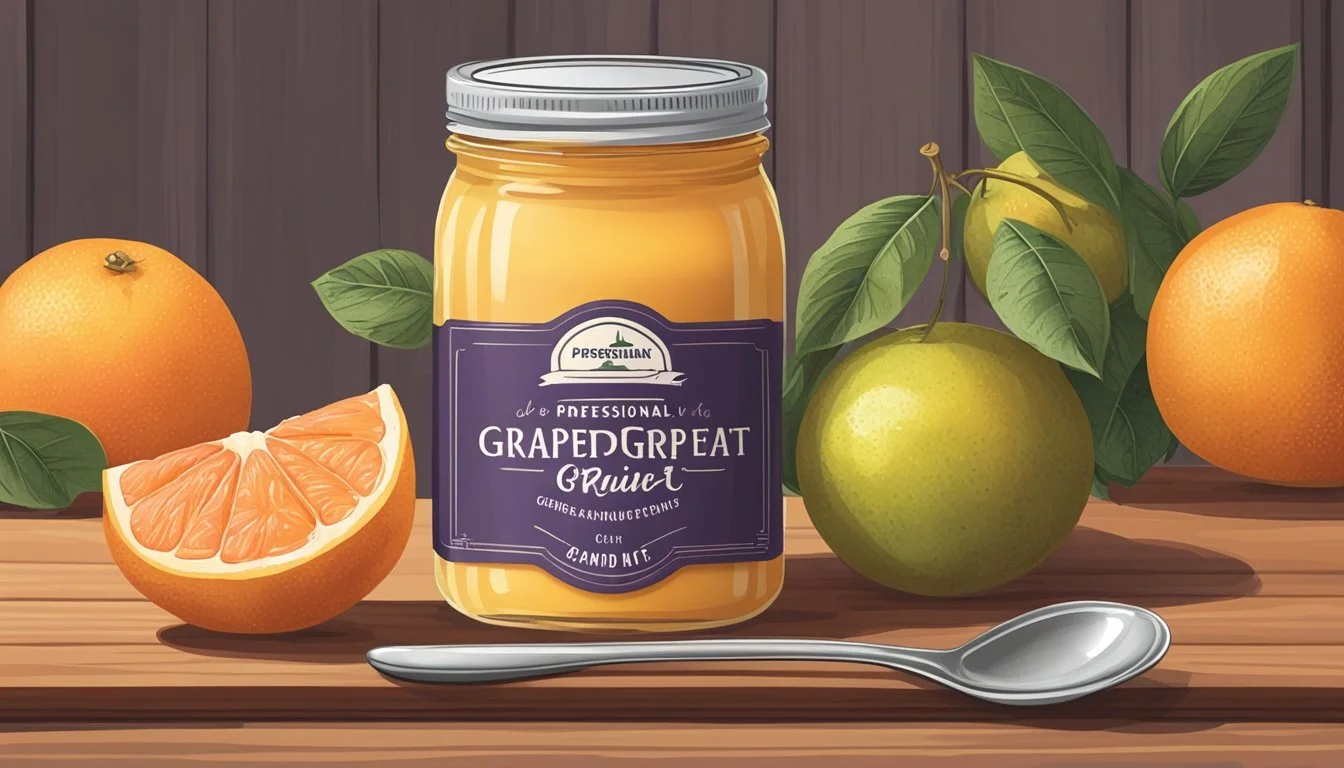How Long Does Canned Grapefruit Curd Last?
Shelf Life Explained
Grapefruit curd is a delicious citrus spread that brightens up many dishes with its vibrant color and tangy flavor. Its longevity is a topic of interest to those who want to preserve the freshness of this homemade condiment. Sealed in an airtight container, freshly made grapefruit curd typically has a refrigerated shelf life of up to two weeks. The high acidity of the citrus contributes to this relatively short but adequate preservation period.
When it comes to canning grapefruit curd for longer shelf life, it's vital to follow proper canning techniques. Canned and sealed under the right conditions, grapefruit curd can last for several months. However, it's critical to store the cans in a cool, dark place and to check regularly for signs of spoilage, such as off smells or colors.
Food safety is paramount, and when discussing preservation, all guidelines must be adhered to meticulously. After opening a can of grapefruit curd, it should be consumed within one to two weeks, and always stored in the refrigerator to maintain its quality and safety. It is essential for consumers to be aware of these time frames to ensure they enjoy their grapefruit curd while it is still at its best.
Understanding Grapefruit Curd
Grapefruit curd is a spread made primarily from grapefruit, a citrus fruit known for its tangy and slightly bitter flavor. This curd variant, like other citrus curds, is a blend of fruit juice, sugar, and eggs, but features the distinct taste of grapefruit.
Comparison with Other Citrus Curds
Grapefruit curd stands out from its citrus-based counterparts, such as lemon curd, due to its unique flavor profile. While lemon curd is characteristically bright and tart, grapefruit curd offers a more nuanced taste with a balance between sweet and bitter notes.
Taste: Grapefruit curd has a more complex flavor, less sharp than lemon.
Color: It typically presents a bold, pinkish hue, compared to the yellow of lemon curd.
Texture: Both curds share a creamy and smooth consistency.
Lemon curd and grapefruit curd share similar preparation techniques and uses in culinary applications, serving as spreads, fillings, or ingredients in various recipes.
Nutrition Profile
The nutrition profile of grapefruit curd includes a range of macros and micronutrients, with its calories stemming mainly from carbohydrates due to the added sugar and fat from the eggs and sometimes butter. Here's a quick breakdown of its nutritional content per typical serving size (about 1 tablespoon):
Nutrient Amount Calories ~50 Fat ~2g Saturated Fat ~1g Carbohydrates ~7g Protein ~1g Fiber <1g Sodium ~10mg Iron <1mg Vitamin C Varies
Vitamin C and fiber content are notable, given the fruit's origin, although they are generally present in lower amounts than in the fresh fruit due to the cooking process and inclusion of other ingredients. The specific nutritional values can vary depending on the recipe and the proportion of ingredients used. Grapefruit curd can add a burst of flavor and a moderate nutritional punch to dishes, but like all curds, should be enjoyed in moderation due to its sugar and fat content.
Ingredients and Recipe
In making grapefruit curd, one combines grapefruit juice and zest with a balance of eggs, sugar, and butter for a smooth, citrusy spread.
Key Ingredients for Grapefruit Curd
To create grapefruit curd, the following key ingredients are required:
Grapefruit: Provides the distinctive tart flavor. Use both juice and zest for an intense citrus taste.
Sugar: Typically, granulated sugar is used to balance the tartness of the grapefruit.
Eggs: Including both whole eggs and egg yolks thickens the curd and adds richness.
Butter: Unsalted butter is melted into the curd for a creamy consistency.
Step-by-Step Curd Preparation
The preparation of grapefruit curd involves several steps that ensure a smooth final product:
Combining the Ingredients: In a saucepan, stir together the grapefruit juice, grapefruit zest, and granulated sugar.
Cooking: Heat the mixture on medium until the sugar dissolves and the mixture simmers. Then, lower the heat.
Eggs Incorporation: In a separate bowl, whisk the egg yolks until smooth. Gradually temper the yolks by adding the hot grapefruit mixture, then return to saucepan.
Thickening the Curd: Continue cooking over low heat, stirring constantly until the mixture thickens enough to coat the back of a spoon.
Finishing Touch: Remove from heat and stir in cubes of unsalted butter, until it melts and the curd is smooth.
Canning Process
The canning process of grapefruit curd is crucial to its longevity and safety. Effective techniques and appropriate equipment ensure an airtight container, which is essential for storage.
Proper Canning Techniques
Canning grapefruit curd involves precise heat application and timing. The curd should be ladled into hot, sterile jars, leaving a 1/4 inch headspace to allow for expansion. Any air bubbles must be removed promptly with a non-metallic tool to prevent potential spoilage. After filling, wiping the rim clean is essential for a proper seal. The lid, usually pre-warmed for better sealing, is then placed on the jar. The filled jars are processed in a pressure canner at the pressure appropriate for their size and the altitude they are being canned at, typically 10 pounds of pressure for 10 minutes. This time and temperature ensure it's canned safely, keeping the contents preserved.
Equipment Needed for Canning
Essential equipment for canning grapefruit curd includes:
Jars: Usually glass, designed for canning
Lids: To create a hermetic seal
Pressure Canner: Essential for high-acid foods like grapefruit
Jar Funnel: Assists in pouring the curd into jars
Jar Lifter: For safely handling hot jars
Clean Cloths: For wiping jar rims
Bubble Remover/Plastic Knife: To release trapped air
Ladle: For transferring curd into jars
Thermally resistant tools and a reliable pressure canner are non-negotiable for a successful canning experience. Each piece of equipment should be in perfect condition to ensure the integrity of the jar's seal, which is integral to the preservation of the canned product. Quality equipment helps maintain the necessary airtight environment for long-term storage of home-canned grapefruit curd.
Shelf Life and Storage
When discussing the shelf life of canned grapefruit curd, it is essential to consider both the optimal storage conditions and the signs that indicate spoilage. Proper storage can maximize longevity, while attention to spoilage indicators ensures safety and quality.
Optimal Storage Conditions
Canned grapefruit curd's shelf life typically extends from 6 to 9 months when stored in a cool, dark location at room temperature. For safety and quality preservation, the curd should be placed in an airtight container. Once opened, it must be refrigerated to extend its freshness, ideally between 36 to 40°F (2 to 4°C). It's recommended to wrap the container with plastic wrap to prevent other flavors from affecting the curd's taste and to keep out excess moisture, which can compromise quality.
Unopened: 6-9 months at room temperature in a cool, dark place
Opened: Refrigerate in an airtight container; consume within 1 to 2 weeks for best quality
Signs of Spoilage and Safety
Detecting signs of spoilage is crucial for ensuring the safety of canned grapefruit curd consumption. A change in color, the presence of mold, or an off-odor indicates that the curd should not be consumed. If the lid of the canning jar appears to be bulging or if there is an unusual fizzing sound upon opening, it's likely that bacteria, such as Clostridium botulinum, have contaminated the product, and it should be discarded immediately.
Visual: Color changes or mold presence
Olfactory: Off-odors signaling spoilage
Auditory: Fizzing sound upon jar opening
Physical: Bulging lid indicates potential bacterial growth
Serving Suggestions
When incorporating grapefruit curd into your meals, the versatility of its vibrant flavor shines through in both sweet and savory dishes. It can act as a sumptuous filling, a complementing condiment, or a delightful topping, enhancing the taste profiles of various courses.
Desserts and Pairings
Cakes and Tarts: A layer of grapefruit curd adds a zesty twist inside a cake or as a flavorful base in a tart. For a simple yet elegant dessert, serve it with pancakes or scones.
Pavlova: Top a classic Pavlova with a generous spoon of curd to balance its sweet meringue with a citrus-infused tartness.
Ice Cream and Yogurt: Swirl the curd into ice cream or yogurt for a refreshing treat that provides a bright burst of grapefruit flavor.
Savory Applications
Saucepan Creations: In a saucepan, gently warm the curd to create a sauce that pairs delectably with grilled meats or as a glaze for roasted vegetables.
Servings as a Condiment: Employ the grapefruit curd as a condiment to liven up the flavor profile of a meal, be it a brunch or a main course, lending a fresh, citrus zing.
Homemade vs Commercial
When considering the longevity of canned grapefruit curd, one must take into account the differences between homemade and commercially-produced products. Both types can yield delicious results, but factors such as taste, texture, and methods of preservation vary significantly.
Differences in Taste and Texture
Homemade grapefruit curd typically features a fresher taste and a more pronounced citrus zing when compared to its commercial counterpart. The texture can be creamier and smoother because it is often made in smaller batches, allowing for more direct control over the consistency.
Homemade Curd:
Taste: Brighter, with a fresh grapefruit flavor
Texture: Smooth and creamy, potentially less uniform
Commercial Curd:
Taste: May be more subdued due to processing and stabilizers
Texture: Thicker and designed for longer shelf life, may include thickeners or additives for consistency
Understanding Commercial Preservation
Commercial preservation techniques are designed to extend the shelf life of canned goods, including grapefruit curd. Manufacturers might use preservatives not commonly used at home to maintain texture and prevent spoilage.
Commercial Techniques:
Employ stabilizers and preservatives to maintain quality over time
Utilize stringent processing methods to meet safety regulations and extend shelf life
In contrast, homemade methods rely on the sterilization of jars and precision in canning technique rather than preservatives. While homemade grapefruit curd may not last as long on the shelf due to the absence of these commercial preservatives, it is generally safe for consumption as long as the seal remains intact and there are no visible signs of spoilage.








